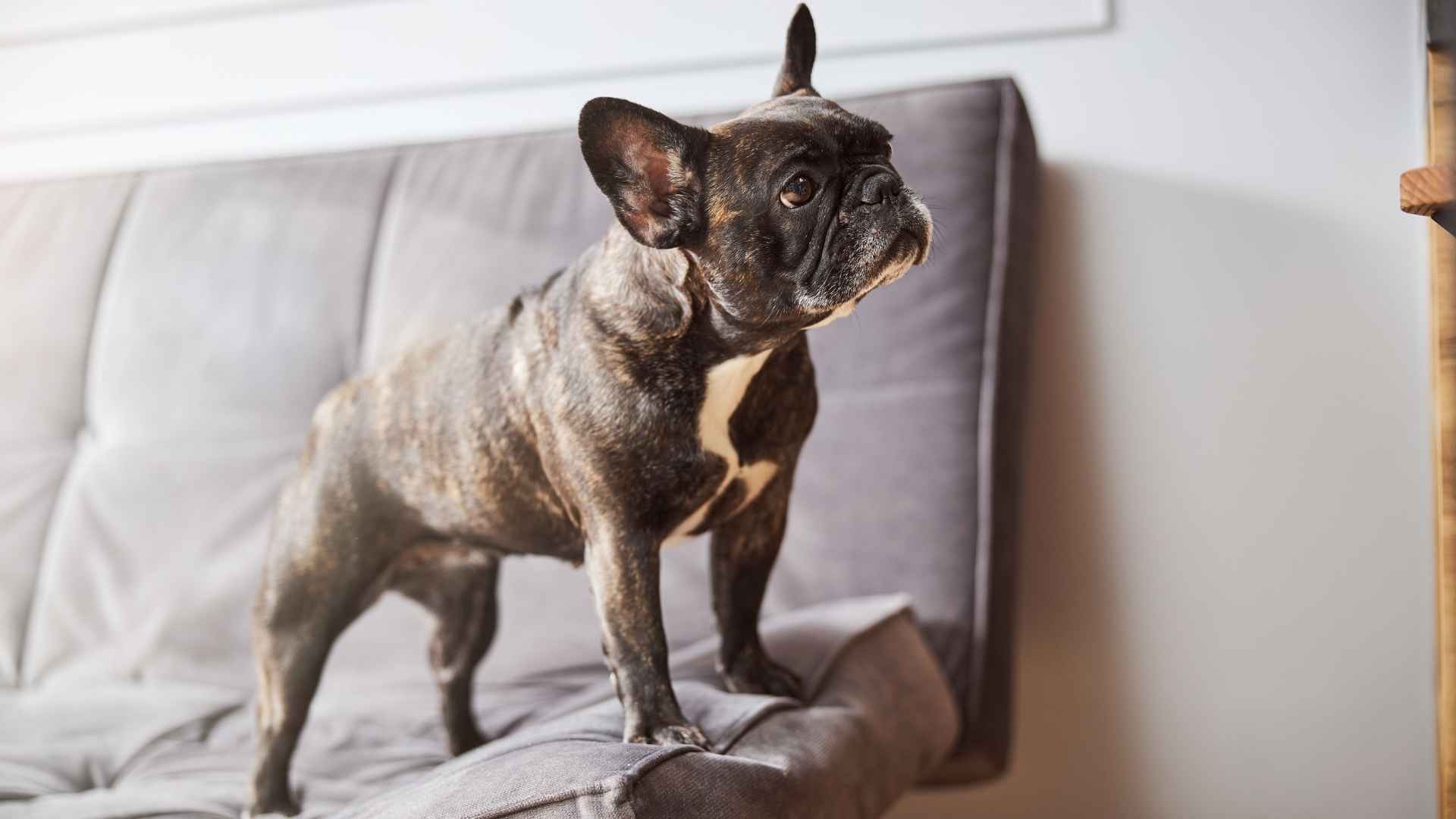A dog doesn’t have to ruin your furniture. That’s a fact. The idea that shedding is just part of dog ownership is outdated. Yes, some breeds turn your couch into a fur blanket—but others are naturally low-shedding, and they make life a lot simpler.
If you’ve been avoiding white clothes or brushing fur off your car seats daily, it might be time for a change. Choosing a dog with a low-shedding coat can make your home feel cleaner, your clothes stay fresher, and your routine easier.
In this article, you’ll find dog breeds that keep their hair to themselves. These aren’t just neat freaks—they’re low-maintenance, stylish, and easy to love. Let’s explore!
Dog Breeds That Don’t Shed On Furniture
1. French Bulldog
The French Bulldog’s smooth, single-layered coat stays tight against the body, making loose hairs less likely to transfer onto surfaces. Their fur doesn’t float in the air or cling to fabric the way longer coats often do. Regular brushing helps remove what little loose hair they naturally shed.
Simple Grooming, Cleaner Furniture
Weekly brushing with a soft-bristle brush helps reduce hair buildup in indoor spaces. Many owners also use grooming mittens to gently lift loose hair before it reaches upholstery. Their coat doesn’t need trimming, so maintenance stays low while keeping shedding minimal.
Less Movement, Less Mess
They prefer soft resting spots and don’t climb or jump around furniture like more active breeds. Most of their time is spent lounging in designated spots, which limits fur spread across multiple surfaces. Their calm temperament works in favor of a tidier living space, as per Purina.
A Compact Pick Among Light Shedders
Among low-shedding dogs, French Bulldogs are known for their manageable coat and low grooming demands. They’re often chosen by people who’ve had issues with shedding from other dogs. Their short fur and minimal molting make them a clean companion for home life.
2. Miniature Schnauzer
Miniature Schnauzers have a double coat, with a wiry outer layer that traps dead hair rather than letting it fall. This unique texture reduces the chance of hair floating onto furniture or clothes. Hand-stripping or clipping keeps the coat healthy and prevents the buildup of loose strands.
Grooming Keeps Shedding in Check
Routine grooming is essential and helps reduce any indoor mess caused by coat changes. Most owners follow a strict brushing and trimming schedule every few weeks. Their coat doesn’t blow seasonally like other breeds, which helps maintain consistent control over shedding.
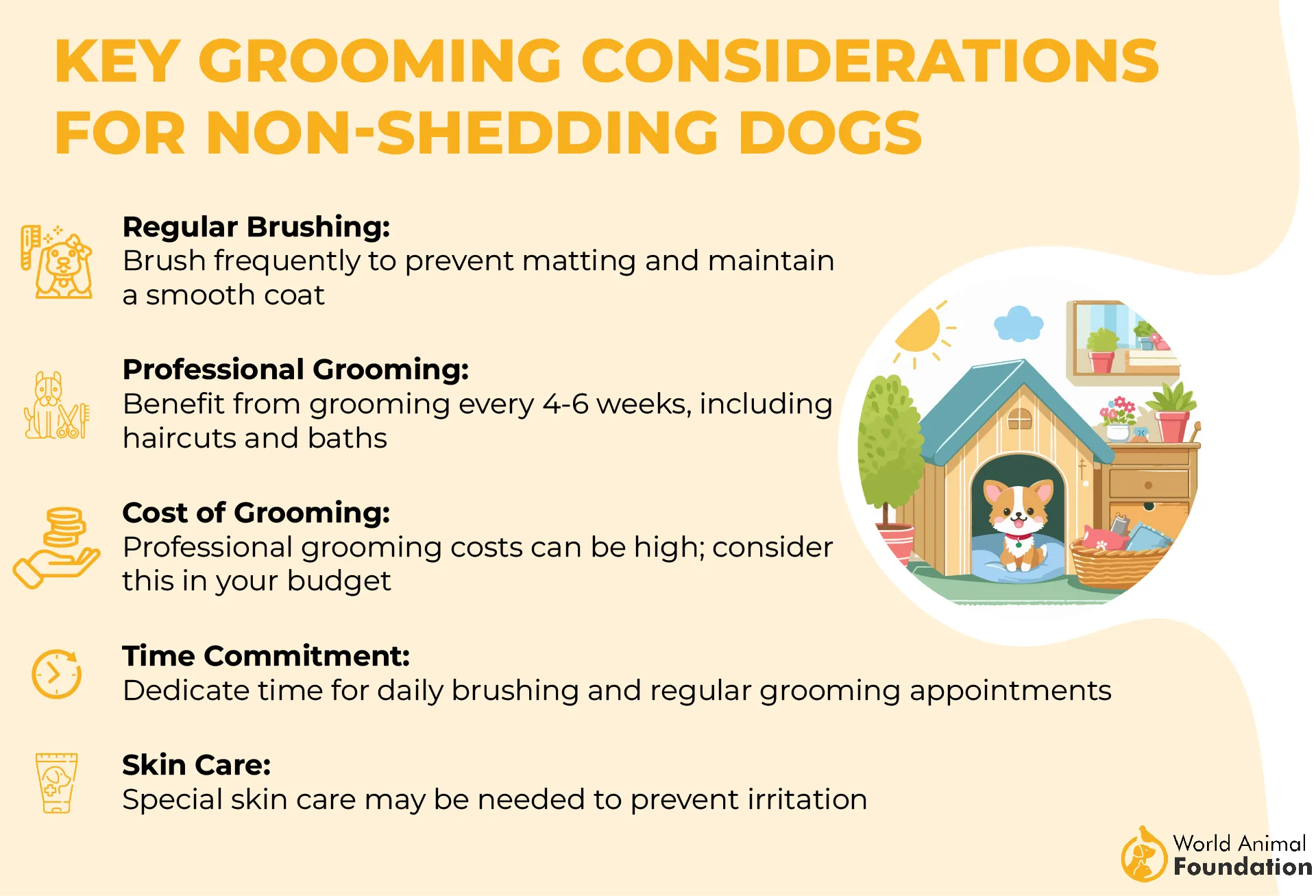
Indoor Behavior Supports Clean Spaces
This breed is energetic but tends to stay close to its favorite spots indoors. They are alert but not destructive, so their movement doesn’t scatter fur across all areas. With training, they learn to rest in specific zones, limiting contact with shared furniture.
Recognized for Low Shedding Potential
Often listed among hypoallergenic dogs, the Miniature Schnauzer’s coat is a common choice for allergy sufferers. Their double-layered fur doesn’t produce as much dander as many other breeds. This makes them a more manageable option for homes with strict cleaning standards.
3. Bichon Frise
The Bichon’s undercoat traps any loose strands, preventing them from falling onto furniture. Their outer coat is soft, curly, and dense, which helps hold shedding within the coat itself. This structure makes them ideal for people wanting a cleaner home environment.
Regular Brushing Is Essential
Because the coat holds onto hair, regular grooming is needed to keep mats and tangles away. Most owners brush them daily to avoid buildup and tangling beneath the curls. Groomers recommend combing down to the skin to reach the denser layers of fur.
Active, But Indoors-Friendly
Bichons are known for playful energy but typically stay low-impact around the house, as stated in the AKC. They’re often satisfied with short bursts of play and don’t roam or jump across furniture constantly. This reduces how far any loose fur might travel indoors.
Recognized for Low Shedding
Many people list them among dogs that don’t shed, thanks to their unique coat structure and grooming routine. While hair does grow continuously, it doesn’t fall out freely like with many double-coated breeds. Grooming replaces natural shedding in their coat cycle.
4. Havanese
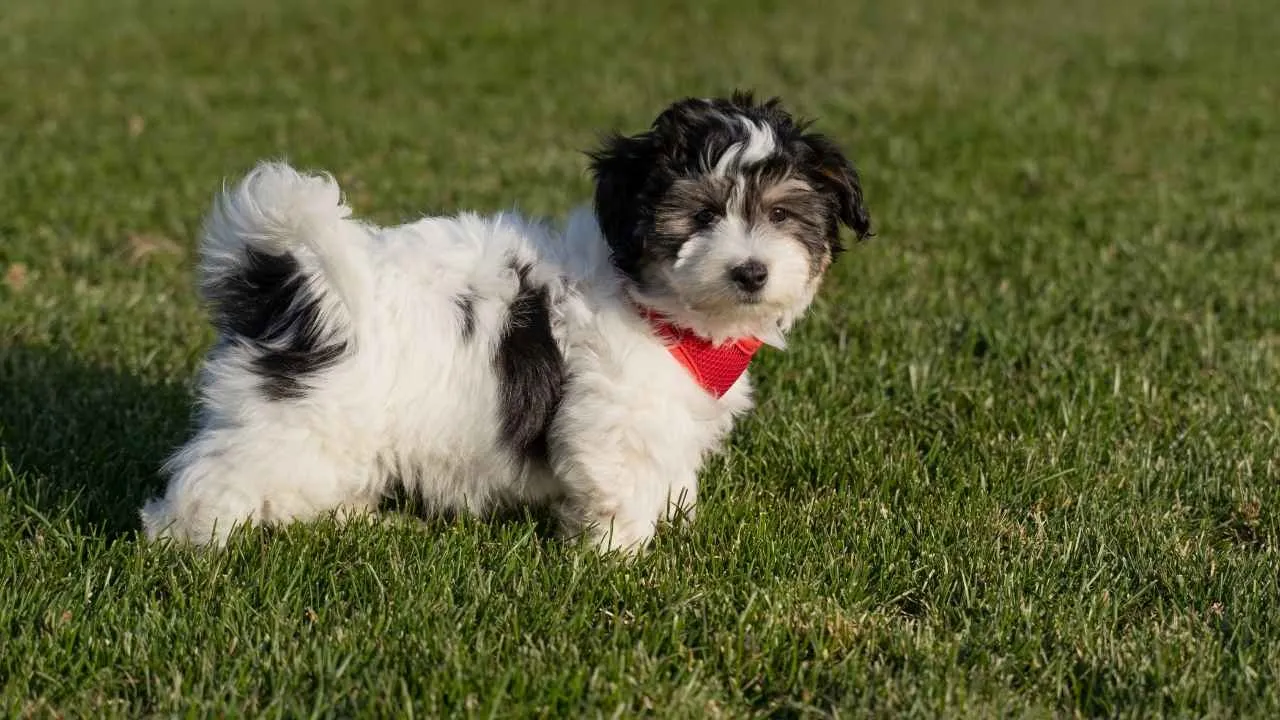
The Havanese has a long, lightweight coat that doesn’t shed in clumps or leave hair on sofas. Their shedding is so minimal that loose hairs often get caught within the coat instead of falling off. This trait helps keep floors and furniture nearly fur-free with proper brushing.
Coat Care That Keeps Hair in Check
Their silky coats require regular combing to prevent tangles and matting, especially behind the ears and under the legs. Grooming helps catch shed hairs before they end up on cushions or blankets. Many owners keep the coat trimmed for easier upkeep in indoor settings.
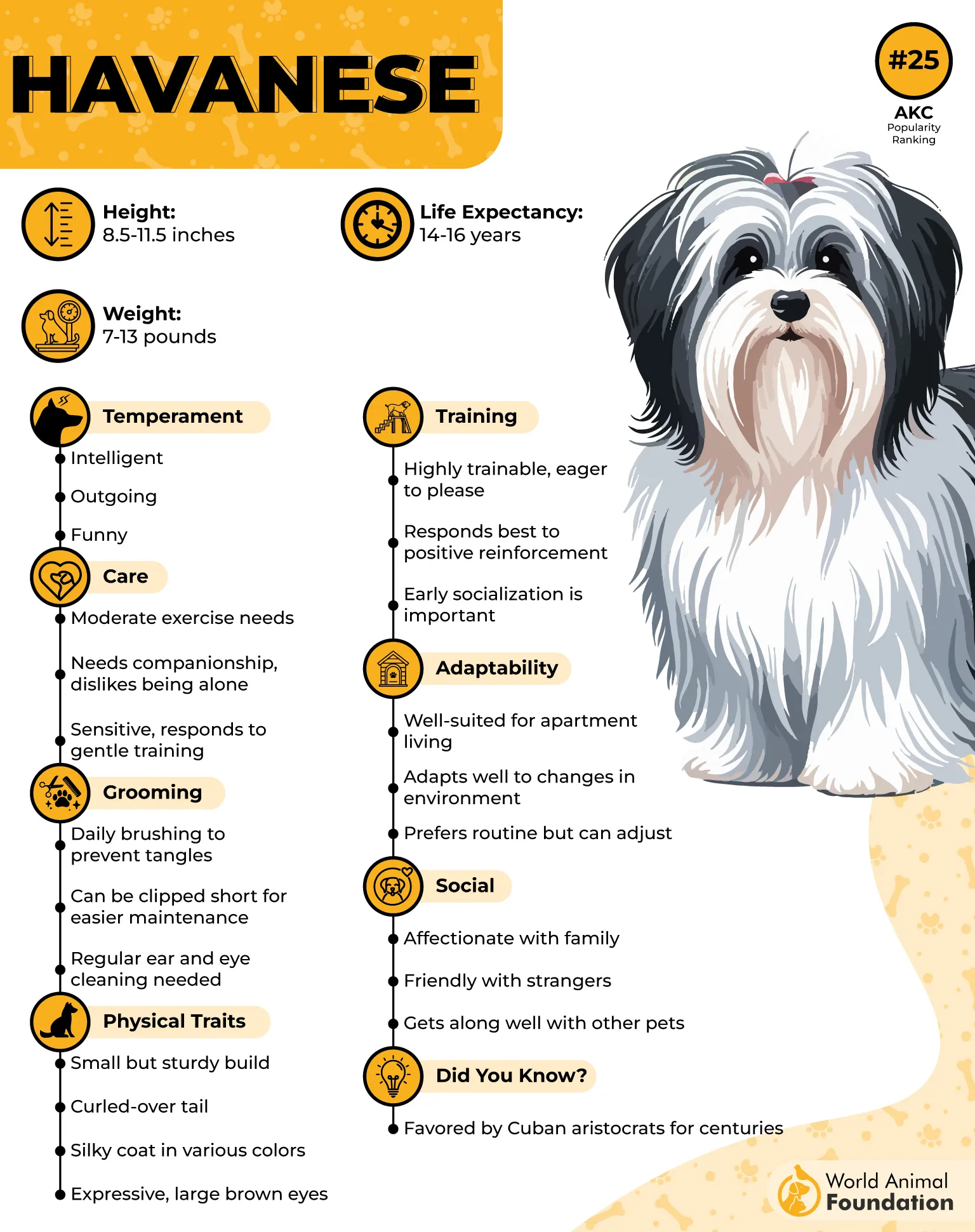
Indoor Behavior Supports Clean Spaces
Havanese are known for shadowing their owners but aren’t naturally high-energy indoors. They tend to settle in preferred resting spots rather than moving constantly from couch to chair. This limits the spread of dander and fur throughout the home.
Naturally Tidy and Family-Oriented
They’re affectionate, adaptable, and often labeled a classic lap dog for their calm presence and love of closeness. Their low dander and light shedding make them a match for people with tidy households. Even with children, their coats don’t become a constant cleanup issue.
5. Maltese
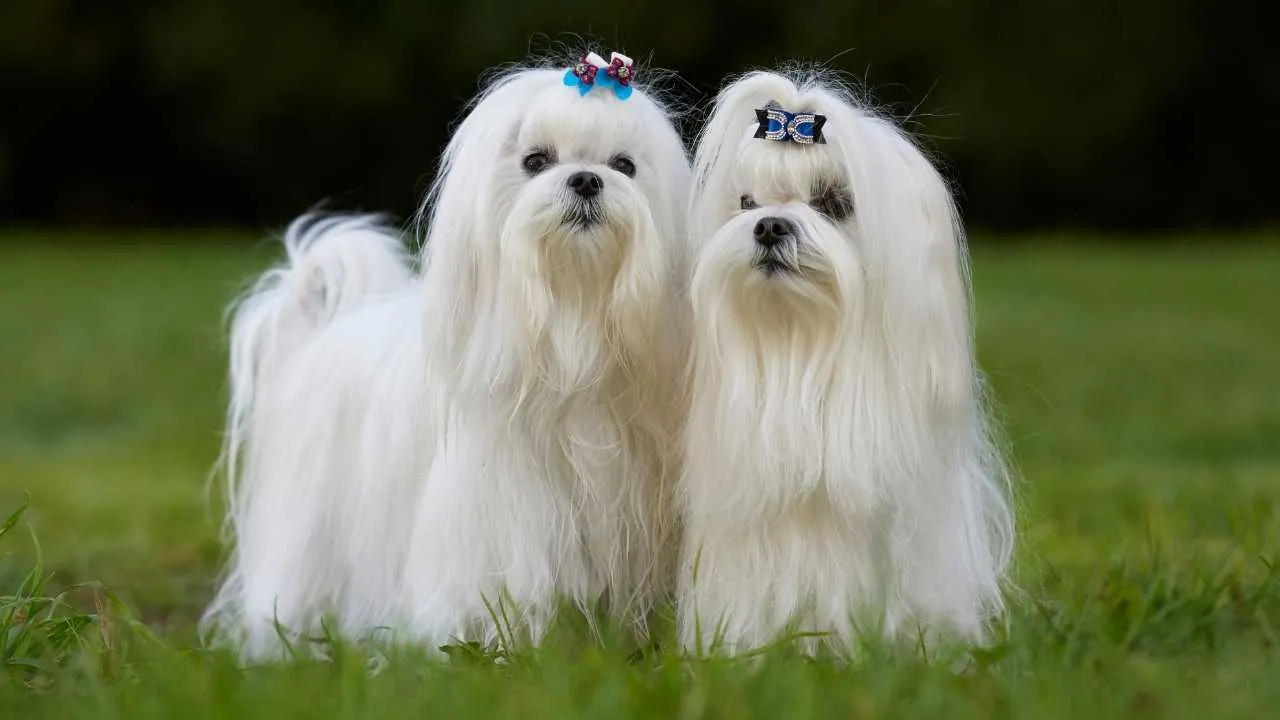
The Maltese has a single-layer coat made of long, flat hair rather than fur, which means minimal to no shedding on furniture. Their hair grows continuously like human strands and lacks an undercoat, reducing loose hair in indoor environments.
Daily Grooming Prevents Stray Hairs
Although they don’t shed heavily, their long hair can tangle if left unattended. Brushing once a day with a pin brush helps keep the coat in place and prevents strands from landing on cushions or floors. Most owners also tie up facial hair to avoid eye staining and matting.
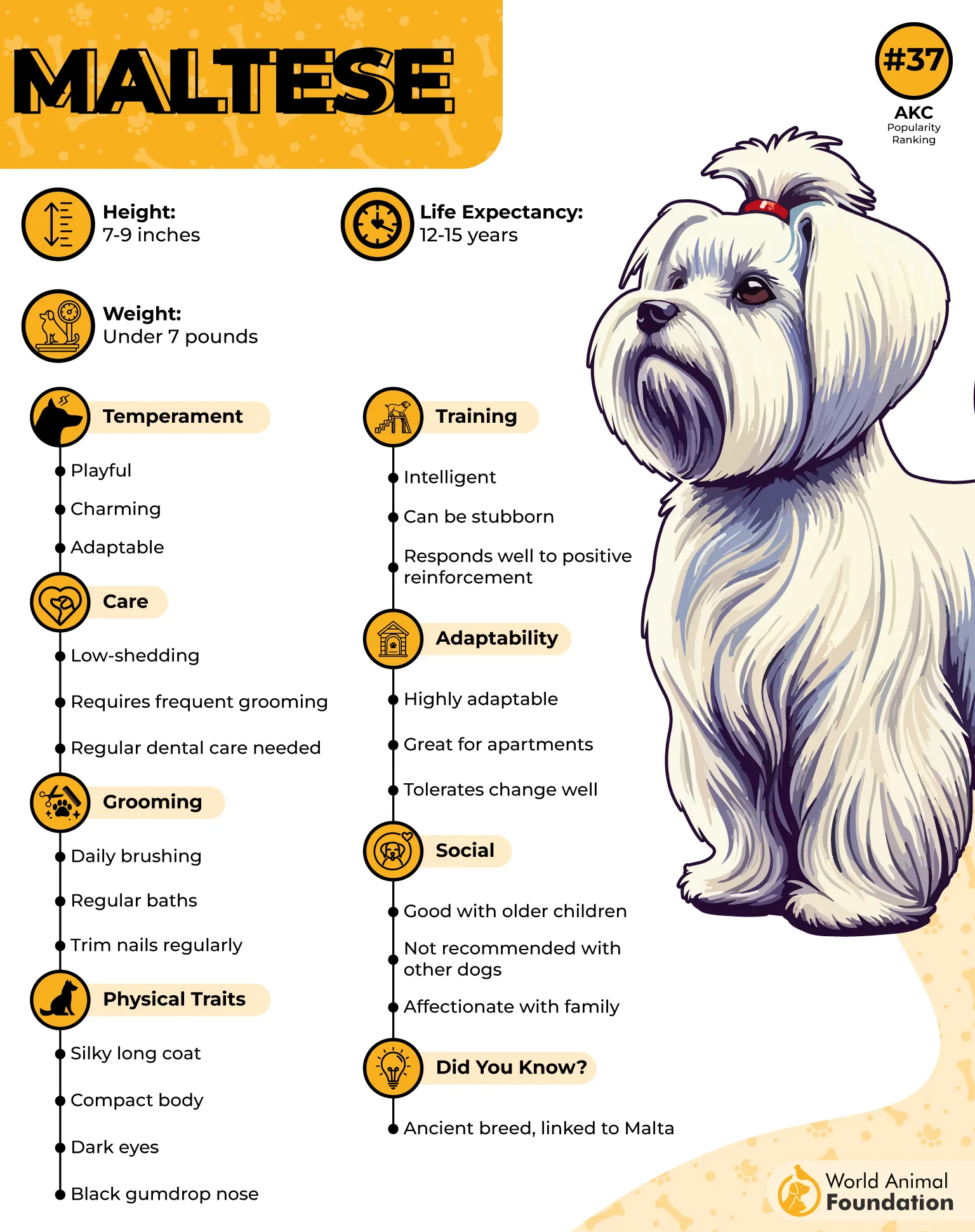
Clean Habits Add to Furniture Appeal
Maltese dogs tend to be light on their paws and often stay within their comfort zones inside the home. Their compact size and predictable resting spots mean fewer chances of spreading hair across the house. They also respond well to routine, which helps keep things tidy.
A Long History of Clean Coats
This breed was originally bred as a companion in wealthy households, where cleanliness was a valued trait. It’s still regarded as a classic non-shedding dog due to its manageable coat. With regular care, they remain visually elegant without turning your furniture into a fur zone.
6. Scottish Terrier
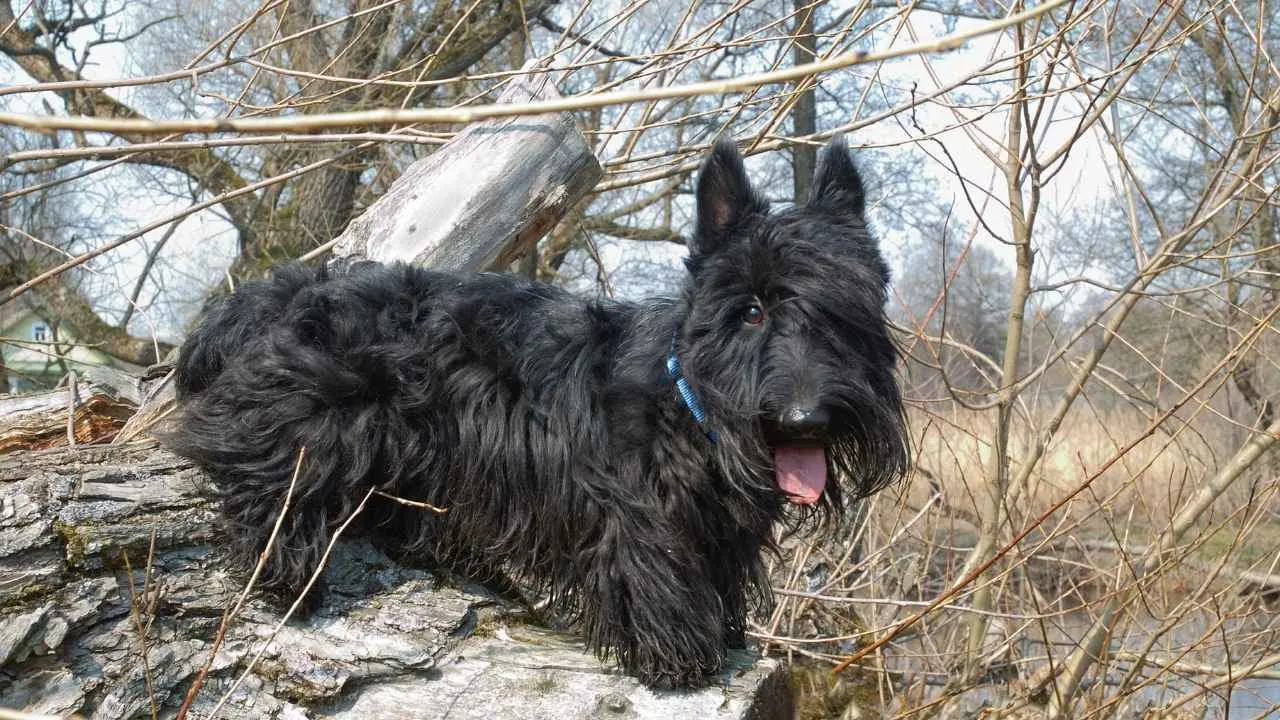
Scottish Terriers have a wiry, weather-resistant topcoat with a soft, dense undercoat beneath. Their fur stays close to the body and doesn’t easily break away onto furniture. Because the coat grows continuously, dead hairs tend to remain trapped until brushed or hand-stripped.
Regular Grooming is Key
They benefit from weekly brushing and periodic hand-stripping, especially around the legs and furnishings. This helps remove dead hair before it can settle indoors. Their coat doesn’t shed in tufts, which means it’s rare to see visible hair scattered across fabric.
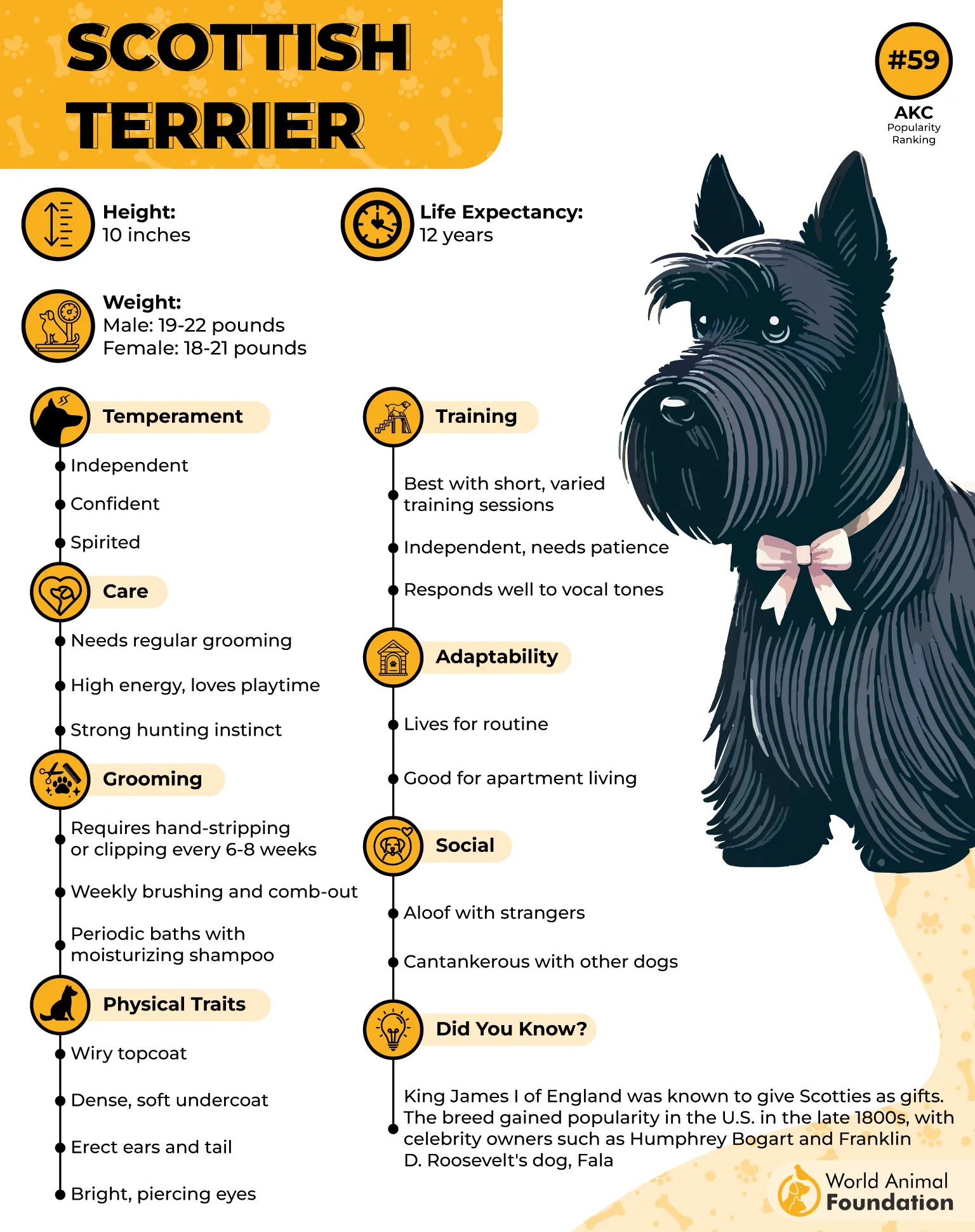
Floor-Oriented Behavior
Scotties prefer staying low to the ground and are not furniture jumpers by nature. Their independent attitude keeps them from hopping between couches or beds frequently. Less contact with fabric surfaces results in less opportunity for coat transfer.
Coat Texture Supports Clean Living
Unlike breeds with soft, shedding undercoats, the Scottish Terrier’s coarse top layer resists air dispersal. Even in seasonal transitions, they don’t blow coat, which helps keep living spaces cleaner. Professional grooming maintains this coat’s shape and cleanliness throughout the year.
7. Yorkshire Terrier
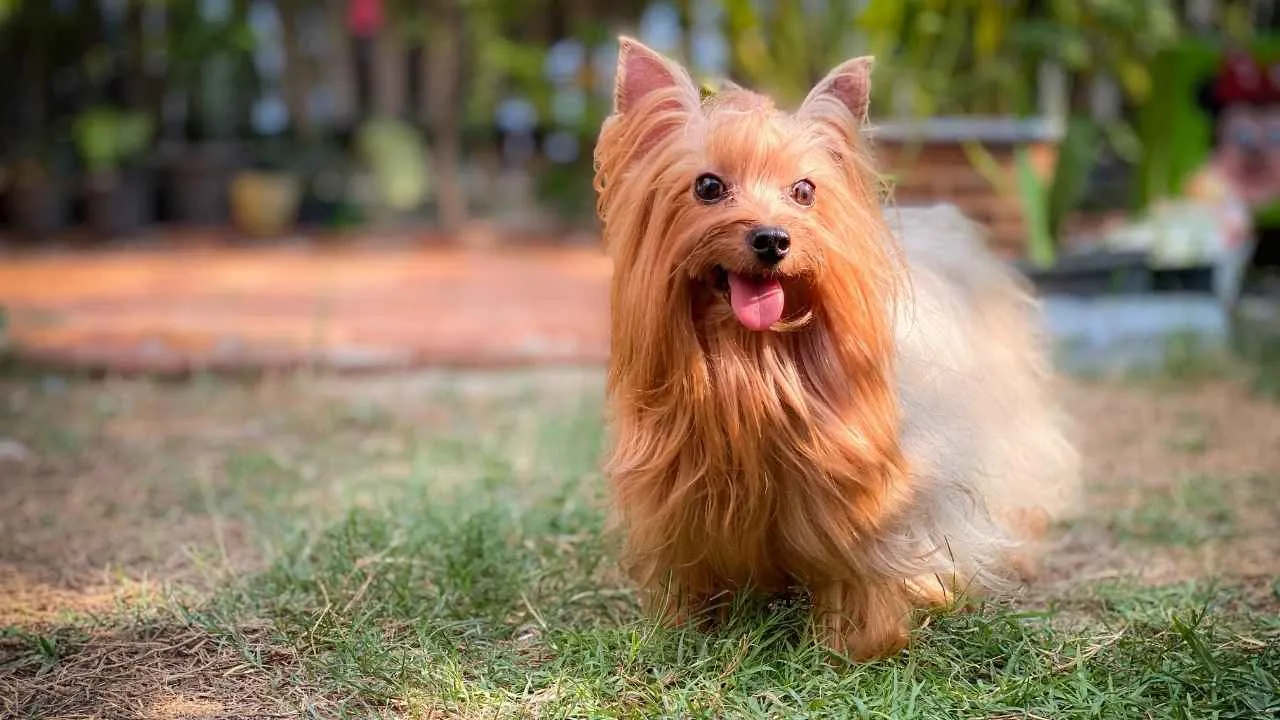
Yorkies have hair, not fur, which grows similarly to human hair in length and texture. Because of this, they don’t release hair strands into the environment as most shedding breeds do. What they do lose is minimal and usually caught in grooming tools, not on furniture.
Grooming Is a Key Factor
Their coat requires regular trimming and brushing to stay free of tangles and prevent loose strands from scattering. A detangling spray is often used before brushing to avoid breakage. Many owners tie up the top knot to keep the coat neat and out of the eyes.
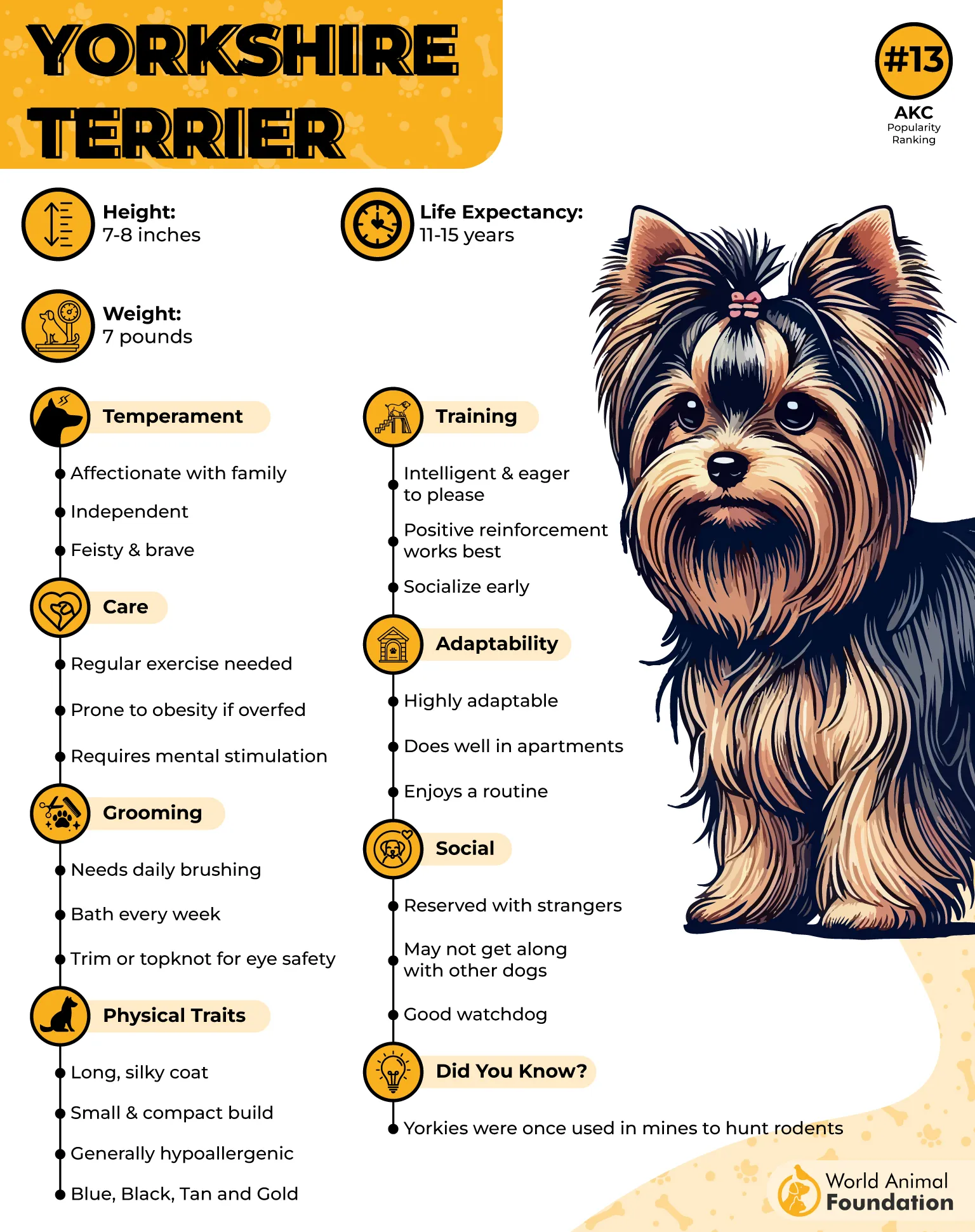
Naturally Light and Compact Movers
Due to their small size and lighter steps, they don’t drag their coat across sofas or rugs. Yorkies also prefer to perch or curl up in designated spots, limiting how much of their coat touches furniture. This behavior contributes to a cleaner indoor space.
Common Practices That Help
Owners often clip their Yorkie’s coat into a shorter, more manageable “puppy cut” to reduce maintenance. Even when kept long, their coat doesn’t release dander-heavy clumps into cushions or fabrics. Their hypoallergenic reputation stems from these coat characteristics and habits.
Conclusion
Not every small dog fills your house with pet hair. Some breeds are just built differently—with fine hair, silky hair, or a curly coat that rarely sheds. That means cleaner cushions, less lint rolling, and more time enjoying your home.
Whether it’s a hardy dog like the Scottish Terrier or a curious dog like the Havanese, each one on this list sheds minimally and brings peace to your furniture. These breeds make life simpler, not messier.
If you’ve been dreaming of a dog that fits your lifestyle and keeps your space tidy, you’ve got options. From coats that trap dog hair to ones with minimal shedding, a cleaner cuddle buddy is waiting.


